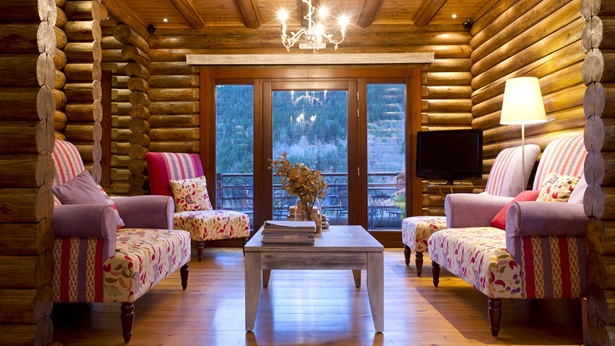Log Home Sealants
In the rush to design your dream home, one has to remember to protect it from Mother Nature once construction is finished. To keep Mother Nature at bay, the log and timber home industry has created a family of products called sealants. These materials keep your new home cozy by sealing the cracks and settling spaces between logs, around doors and window frames.
They will also reduce heating or cooling costs, protect against water infiltration and keep out uninvited guests, such as insects and decay. Keep this information handy whether you are planning a new log and timber home, contemplating an addition or remodeling project, or just want to keep your dream home warm and comfortable.
Basic Knowledge
- Only Use Log Home Products: Don’t try to use similarly named products from your local home center to seal your home. For example, log and timber home sealants are sometimes referred to as “caulk” because they are applied with a caulk gun. But log and timber home sealants are specially formulated to adhere to wood and expand and contract with the logs. They bear no resemblance to the caulk used in conventional construction.
- Chemical Compatibility: Products are either oil- or water-based. If you change product lines, you may have to strip the sealants and stains from the home and start over.
- Read The Directions: If you are a DIY’er, remember to follow the directions of each product. Ignore this crucial step and you can make colossal errors. Many sealant manufacturers offer how-to videos and classes around the country as well as videos and instructions online.
Physical Sealants
The sealants used on your home will depend on the building system recommended by your log and timber home producer. Your builder may employ all or some of these physical sealants during construction.
- Splines: Splines are used between courses of logs (laterally), between ends (known as butt joints) and between logs and windows and door jams. Splines can be made of wood, vinyl or masonite.
- Gaskets Or Sealant Tape: Log sealant tape (sometimes called gaskets) are flexible strips of synthetic foam that are sometimes used between courses of logs or around doors and windows; this material can take the movement of log walls and still keep a tight seal.
- Synthetic Foam: This synthetic foam used is placed in joints between log courses and around doors and windows to provide an extra level of insulation, as well as a surface that chemical sealant won’t adhere to. Sometimes called “Bond Breakers,” they come in a variety of shapes and sizes, from sheets and to rope-like lengths.
- Bond Breaker Types: There are three main varieties of bond breakers.
- Closed-cell gaskets are infused with chemicals to resist moisture and insects. They are used only on exterior wall applications because of chemical off-gassing.
- Open-cell gaskets are usually recommended for interior applications only, since it does not cause off-gassing like closed cell will.
- A third product that offers characteristics of both (called “dual”) and is used in Swedish cope style as an internal seal.
- Log Home Wool: This is wool infused with borates (an environmentally safe material) to resist water and insects. It’s used in between log courses and at corner sections. Besides have an insulating quality, this material wicks moisture instead of absorbing it.
Chemical Sealants
Chemical sealants are one of the last products applied to your new home after construction, but one of the first lines of defense against Mother Nature. Using a caulk gun, a paste-like material is injected into all vertical and horizontal crevices. This includes between log courses, by window and doorframes, by the roof system—any place where water or insects can penetrate. Once dry, the sealant keeps out Mother Nature.
Sealants can blend with your stain on your logs to be nearly invisible, or they can be a wide band of material that’s a different color than your logs to serve as dramatic architectural counterpoint—sometimes called chinking. Chinking is popular with log and timber homeowners who want their home to have a historic look.
Can you stain your logs before applying sealant or chinking? Or should you seal the home, then stain? The answer depends on the product line you choose. This is why you’ll need to consider a strategy when selecting you’re your sealing products, which will determine in what order they should be applied to your home.
Sealant Pros & Cons
Sealants are either acrylic (water-based) or urethane-based. Here are the key differences.
Pros for Water-Based: Environmentally friendly. Will set up in one to four hours. Resistant to ultraviolet rays. Compatible with a variety of stains and preservatives. Comes in a variety of colors with a lifetime warranty. Clean up is easy—just use soap and water.
Cons for Water-Based: May not adhere well if it rains within one to four hours after application. Dries quickly under hot sun, making it hard to tool it into place. You may need to use a tarp to shield the wall you are working on from a bright sun. Works best if applied when temperature is between 40 and 90 degrees. Does not adhere to all stains.
Pros for Urethane-Based: Unaffected if it rains shortly after application. Instead, the rain will actually help the sealant set-up. It cures even in low temperatures, making it useful for northern climates. Can be stained or sanded. It’s also more pest resistant than water based caulks.
Cons for Urethane-Based: Smell may be offensive to some. Not compatible with some preservatives, stains and finish coats. Mineral spirits are needed for clean up, which can be a fire hazard. Not as environmentally friendly.
Cost: Sealants made specifically for log and timber homes, generally cost about $150 per case for 10 30-ounce tubes (or $70 for 30 11-ounce tubes) or $180 for a five-gallon pail.
How much sealant you need, will depend on the lineal feet of logs in your home and the depth and width of the joints to be sealed.
Chinking Pros & Cons
In pioneer days, wide bands of chinking (usually clay mixed with straw) was used in between log courses to keep weather out. Thankfully, modern chinking products is far more technologically advanced, offering unsurpassed performance. Today’s chinking remains soft and pliable for years after being applied and it very rarely fails.
Most chinking products are acrylic-based.
Pros: Once you get the hang of it, it’s easy for a DIY’er to apply to a home, especially if you buy five-gallon pails of chinking and then use a bulk-loading gun.
Cons: Chinking can blister if it is applied incorrectly, or if water vapor or sap are present in the wood. If it blisters, you’;ll have to pop that blister, sand it, and re-apply chinking. Because chinking fills wide gaps, you need to install a bond breaker between log courses before applying it.
Cost: Chinking cost around $160 for a five-gallon pail. The cost of having a home chinked by a professional ranges from $2.50 to $5 lineal foot for one face of your logs (depending on labor costs in your market), double that for both faces. This includes labor and materials.
Choosing Between Pros or DIY’er
Whether you’ll want to seal your home yourself or hire a professional depends on a host of factors, including your budget, how experienced you are, the terrain of your home site (hillsides are more difficult), time of year you need to get it done (harsh weather slows work dramatically) and available time you have. Most homeowners elect to hire a contractor for this because the work is physically difficult (can be dangerous) and the skill level is fairly advanced.
Glossary
Bond Breaker: Rope like strips of synthetic foam used between wood surfaces and chemical sealants to accommodate the normal expansion and contraction of the logs.
Chemical Sealants: A paste-like material, usually called sealants or chinking (sometimes called caulk) is applied with caulk guns and then hardens to form a flexible barrier against water and insects.
DIY’er: Do-it-yourselfer
Log Home Wool: Wool infused with borates, it comes in ropes and sheets (also known as batts), with the latter being used on corner sections and the former for linear applications between logs.
Physical Sealants: Used to seal log courses and around doors and windows, it can include splines, gaskets, tape, synthetic foam or log wool.
Spline: Serves as a bridge between two objects by fitting into a groove or slot in each.
Tape: Log home tape (sometimes called gaskets) are typically placed between the courses of logs and at corner sections to prevent drafts.



